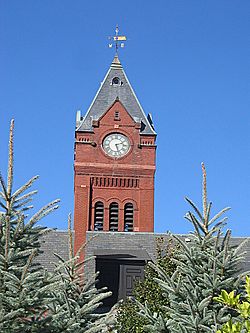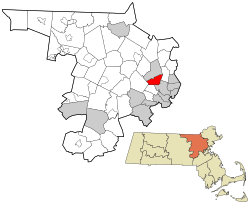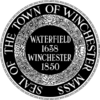Winchester, Massachusetts facts for kids
Quick facts for kids
Winchester, Massachusetts
|
||
|---|---|---|

Winchester Town Hall
|
||
|
||

Location in Middlesex County in Massachusetts
|
||
| Country | ||
| State | ||
| County | Middlesex | |
| Region | New England | |
| Settled | 1640 | |
| Incorporated | 1850 | |
| Named for | William P. Winchester | |
| Government | ||
| • Type | Representative town meeting | |
| Area | ||
| • Total | 16.3 km2 (6.3 sq mi) | |
| • Land | 15.6 km2 (6.0 sq mi) | |
| • Water | 0.6 km2 (0.3 sq mi) | |
| Elevation | 19 m (62 ft) | |
| Population
(2020)
|
||
| • Total | 22,970 | |
| • Density | 1,472.4/km2 (3,828.3/sq mi) | |
| Time zone | UTC-5 (Eastern) | |
| • Summer (DST) | UTC-4 (Eastern) | |
| ZIP code |
01890
|
|
| Area code(s) | 339 / 781 | |
| FIPS code | 25-80510 | |
| GNIS feature ID | 0618247 | |
Winchester is a town in Middlesex County, Massachusetts, USA. It is located about 8 miles (13 km) north of downtown Boston. This means it is part of the larger Greater Boston area.
Winchester is known as one of the wealthiest towns in Massachusetts. In 2020, about 22,970 people lived here.
Contents
Discovering Winchester's Past
Early Days and Native Americans
For thousands of years, Native Americans lived in the area that is now Winchester. When Europeans first arrived, the Naumkeag people lived here. The land was bought from them in 1639 to create the settlement of Charlestown.
From the 1600s to the mid-1800s, parts of other towns like Arlington, Medford, Cambridge, and Woburn made up what is now Winchester. At first, people called the area Waterfield. This was because of its many ponds and the river that ran through the main village. Later, it was known as Black Horse Village, named after a busy inn there.
Growth in the 1800s and 1900s
Winchester grew a lot as transportation improved. The Middlesex Canal was built through the area before Winchester became a town. This canal connected the Merrimack River to Boston. It was used from 1803 to 1836.
Then, the Boston and Lowell Railroad was built. It went right through the town and had two stations. The railroad could carry both people and goods. It soon caused the canal to close down. More people started to move to Winchester because of the easy travel.
The first church was built in 1840, and the Post Office opened in 1841. Soon after the town was officially formed, schools were started. Different industries also began, like the Beggs and Cobb tannery (which processed animal hides) and the Winn Watch Hand factory. These factories operated for many years.
During the American Civil War, many Winchester citizens joined the fight. After the war, the town needed a better water supply. Engineers convinced people to build a dam in the hills east of town. This dam blocked a creek from the Middlesex Fells Reservation. It created the first of three reservoirs that still provide clean water today.
In the early 1900s, Winchester continued to grow. It changed from a farming and factory town to a place where people lived and commuted to work in nearby cities. Many different groups of immigrants moved to Winchester. These included Irish families in the north and east, some African-Americans, and Italian families who worked on farms and lived in the "Plains" area. These new residents joined the original Yankee families.
Winchester's Geography
Winchester covers about 6.3 square miles (16.3 km2). Most of this area, 6.0 square miles (15.6 km2), is land. About 0.2 square miles (0.6 km2) is water.
A central valley runs through the town. This valley is what is left of the original path of the Merrimack River. After glaciers changed the Merrimack River's course, only the Aberjona River remained. The Aberjona River flows through Winchester and feeds several ponds before reaching the Mystic Lakes on the town's southern border.
To the east, the valley rises steeply into the wooded hills of the Middlesex Fells Reservation. Here you can find the North, Middle, and South Reservoirs. The western side of the valley borders Arlington and Lexington. To the north, Winchester shares its longest border with Woburn.
Winchester has several important bodies of water. These include the Mystic Lakes, Wedge Pond, and Winter Pond. The Aberjona River is also a major waterway. Smaller water areas include Sucker Brook and Sachem Swamp.
Winchester shares its borders with the towns of Woburn, Stoneham, Medford, Arlington, and Lexington.
People of Winchester
| Historical population | ||
|---|---|---|
| Year | Pop. | ±% |
| 1850 | 1,353 | — |
| 1860 | 1,937 | +43.2% |
| 1870 | 2,645 | +36.6% |
| 1880 | 3,802 | +43.7% |
| 1890 | 4,861 | +27.9% |
| 1900 | 7,248 | +49.1% |
| 1910 | 9,309 | +28.4% |
| 1920 | 10,485 | +12.6% |
| 1930 | 12,719 | +21.3% |
| 1940 | 15,081 | +18.6% |
| 1950 | 15,509 | +2.8% |
| 1960 | 19,376 | +24.9% |
| 1970 | 22,269 | +14.9% |
| 1980 | 20,701 | −7.0% |
| 1990 | 20,267 | −2.1% |
| 2000 | 20,810 | +2.7% |
| 2010 | 21,374 | +2.7% |
| 2020 | 22,970 | +7.5% |
| 2022* | 22,640 | −1.4% |
| * = population estimate. Source: United States Census records and Population Estimates Program data. |
||
In 2010, there were 21,382 people living in Winchester. There were 7,647 households and 5,785 families. The town had about 3,394.6 people per square mile.
About 87.1% of the people were White, and 9.3% were Asian. About 1.0% were African American, and 0.1% were Native American. About 1.9% of the population was Hispanic or Latino.
Many households (40.5%) had children under 18 living with them. Most households (65.7%) were married couples. The average household had 2.75 people, and the average family had 3.26 people.
About 28.7% of the population was under 18 years old. About 16.2% were 65 years or older. The average age in Winchester was 42.7 years. The population was 52.3% female and 47.7% male.
In 2008, the average income for a household in Winchester was about $125,952. The average income for a family was over $200,000. The average income per person was $68,479. The average home value was $838,420.
Winchester was ranked number 86 on the Bloomberg list of America's 100 Richest Places in 2016. The average household income there was $204,878.
Education in Winchester
Public Schools
Winchester has five elementary schools: Ambrose, Lincoln, Lynch, Muraco, and Vinson-Owen. It also has one middle school, McCall Middle School.
Winchester High School is considered one of Boston's top public high schools. It was first built in 1850. The high school was rebuilt in 1972 and renovated in 2017. Winchester public schools do very well on the MCAS exams. The school district is often ranked as one of the best in Massachusetts.
The Winchester High School sports teams were once called the "Sachems." This term refers to leaders of Native American nations. However, this mascot was removed in 2020 because it was seen as offensive. Now, the sports teams are called the "Red and Black," which are the school's colors.
The Winchester Sports Foundation helps support sports programs in the town. It raises money to make sure sports are available to all students. The teams practice and play home games at Knowlton Field.
Private Schools
The Children's Own School was founded in 1942. It is one of the oldest Montessori schools in the United States. The school's founder, Dorothy Gove, learned directly from Maria Montessori. Today, it is a private, non-religious Montessori school for children aged two to six.
Winchester also has two cooperative nursery schools run by parents: Neighborhood Cooperative Nursery School and Winchester Cooperative Nursery School. Other preschool classes are offered by the Methodist church, Winchester Recreation Department, and Creative Corner.
St. Mary's School is a Catholic school that opened in 1914. It has over 200 students from Pre-K to 5th grade. The school building is also used for Sunday school classes. The church itself is a historic building.
Acera School is a small private school that moved to Winchester in 2013. It offers education for grades K-8 in small classrooms with mixed ages.
The Winchester School of Chinese Culture was started in 2004. It teaches Chinese language and traditional culture. The school offers weekend programs, after-school programs, and a summer program.
Getting Around Winchester
Winchester has two train stops on the MBTA Commuter Rail Lowell Line: Wedgemere and Winchester Center. These stops are close enough to walk between them. The Lowell Line goes from Lowell to Boston's North Station. From North Station, you can connect to the "T", which is Boston's subway system.
The Anderson Regional Transportation Center is nearby. It has a stop for Amtrak's Downeaster train. This train travels through New Hampshire and ends in Brunswick, Maine. While the train goes through Winchester, it does not stop at the town's stations.
Bus lines also run through Winchester to nearby towns like Medford, Arlington, and Cambridge. Bus route No. 134 goes between North Woburn and Wellington Station on the MBTA's Orange Line in Medford. Bus route No. 350 travels from the Burlington Mall to Alewife station in Cambridge on the MBTA's Red Line.
The Anderson Regional Transportation Center also offers a Logan Express shuttle bus service to Boston's Logan Airport every 30 minutes. There is also a paid shuttle service to Manchester New Hampshire Airport, but you need to book it in advance.
Winchester Today
In December 2010, Winchester was named a "Green Community" by the Massachusetts Department of Energy Resources. This means the town is committed to using clean energy. In 2011, Winchester was chosen for a program that helped homeowners install solar panels on their roofs. During that year, 35 residents put in solar systems.
More recently, in July 2014, Winchester received a grant to help install 1668 LED street lights. It is estimated that these new lights could save the town about $50,000 in electricity costs each year.
Across from the high school is the Jenks Community Center. It offers programs for seniors and other age groups. Wedge Pond is a popular swimming spot with Borggaard Beach and Splash Park. The water quality there is always checked to make sure it's safe.
Every year, for over a century, thousands of fans attend the Thanksgiving Day football game. It's a big rivalry between Winchester High School and Woburn.
Several private groups offer fun activities for local residents. The Winchester Boat Club was founded in 1900 as a canoe club. Today, it's a popular place for families to sail on the Mystic Lakes. The Winchester Country Club has an 18-hole golf course.
Places to Visit
- Middlesex Fells Reservation
- Wright-Locke Farm
- John Mason House
- Sanborn House
- Griffin Museum of Photography
- Capt. Josiah Locke House
Sister City
Winchester has a sister city relationship with St. Germain-en-Laye, France.
Famous People from Winchester
Many notable people have lived in Winchester, including:
- Lars Ahlfors, a famous mathematician.
- Joe Bellino, a Heisman Trophy winning football player.
- John Cazale, an actor known for his role in The Godfather.
- Allan McLeod Cormack, who won the Nobel Prize in Physiology or Medicine.
- Edward Everett, a former president of Harvard University and governor of Massachusetts.
- Jon Favreau, a speechwriter for President Barack Obama.
- Vic Firth, a musician and creator of drumsticks.
- Kofi Kingston, a professional wrestler.
- Corey Kluber, a Major League Baseball pitcher.
- Pedro Martínez, a Major League Baseball pitcher.
- Samuel W. McCall, a US congressman and governor of Massachusetts.
- Mark A. Milley, the Chairman of the Joint Chiefs of Staff.
- Richard Phillips, a merchant mariner whose ship was hijacked by pirates.
- Alicia Sacramone, an Olympic silver medalist in gymnastics.
- Richard R. Schrock, who won the Nobel Prize in Chemistry.
- Claude Shannon, known as the "father of information theory."
- Maribel Vinson, a 9-time national champion figure skater.
- Brad Whitford, guitarist for the band Aerosmith.
- Brian Wilson, a baseball pitcher.
See also
 In Spanish: Winchester (Massachusetts) para niños
In Spanish: Winchester (Massachusetts) para niños



